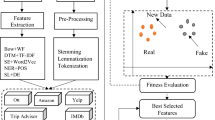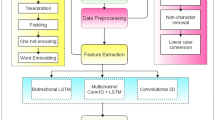Abstract
Advanced neural language models (NLMs) are widely used in sequence generation tasks because they are able to produce fluent and meaningful sentences. They can also be used to generate fake reviews, which can then be used to attack online review systems and influence the buying decisions of online shoppers. To perform such attacks, it is necessary for experts to train a tailored LM for a specific topic. In this work, we show that a low-skilled threat model can be built just by combining publicly available LMs and show that the produced fake reviews can fool both humans and machines. In particular, we use the GPT-2 NLM to generate a large number of high-quality reviews based on a review with the desired sentiment and then using a BERT based text classifier (with accuracy of 96%) to filter out reviews with undesired sentiments. Because none of the words in the review are modified, fluent samples like the training data can be generated from the learned distribution. A subjective evaluation with 80 participants demonstrated that this simple method can produce reviews that are as fluent as those written by people. It also showed that the participants tended to distinguish fake reviews randomly. Three countermeasures, Grover, GLTR, and OpenAI GPT-2 detector, were found to be difficult to accurately detect fake review.
Access this chapter
Tax calculation will be finalised at checkout
Purchases are for personal use only
Similar content being viewed by others
Notes
- 1.
- 2.
- 3.
- 4.
An image of the interface is available at https://nii-yamagishilab.github.io/fakereview_interface/.
References
Bengio, Y., Ducharme, R., Vincent, P., Jauvin, C.: A neural probabilistic language model. JMLR 3(Feb), 1137–1155 (2003)
Lu, S., Zhu, Y., Zhang, W., Wang, J., Yu, Y.: Neural text generation: past, present and beyond, CoRR, abs/1803.07133 (2018)
Bahdanau, D., Cho, K., Bengio, Y.: Neural machine translation by jointly learning to align and translate. In: ICLR (2015)
Vinyals, O., Toshev, A., Bengio, S., Erhan, D.: Show and tell: a neural image caption generator. In: CVPR (2015)
See, A., Liu, P.J., Manning, C.D.: Get to the point: Summarization with pointer-generator networks. In: ACL, pp. 1073–1083 (2017)
Serban, I.V., Sordoni, A., Bengio, Y., Courville, A., Pineau, J.: Building end-to-end dialogue systems using generative hierarchical neural network models. In: AAAI (2016)
Sundermeyer, M., Schlüter, R., Ney, H.: LSTM neural networks for language modeling. In: INTERSPEECH (2012)
Luca, M., Zervas, G.: Fake it till you make it: Reputation, competition, and Yelp review fraud. Manage. Sci. 62, 3412–3427 (2016)
Yao, Y., Viswanath, B., Cryan, J., Zheng, H., Zhao, B.Y.: Automated crowdturfing attacks and defenses in online review systems. In: CCS, pp. 1143–1158 (2017)
Juuti, M., Sun, B., Mori, T., Asokan, N.: Stay on-topic: Generating context-specific fake restaurant reviews. In: ESORICS (2018)
Radford, A., Wu, J., Child, R., Luan, D.: Amodei, D., Sutskever, I.: Language models are unsupervised multitask learners (2019)
Devlin, J., Chang, M.-W., Lee, K., Toutanova, K.: BERT: pre-training of deep bidirectional transformers for language understanding, arXiv preprint arXiv:1810.04805 (2018)
He, R., McAuley, J.: Ups and downs: modeling the visual evolution of fashion trends with one-class collaborative filtering. In: WWW, pp. 507–517 (2016)
Zhang, X., Zhao, J., LeCun, Y.: Character-level convolutional networks for text classification. In: NeuRIPS, pp. 649–657 (2015)
Zellers, R., Holtzman, A., Rashkin, H., Bisk, Y., Farhadi, A., Roesner, F., Choi, Y.: Defending against neural fake news, arXiv preprint arXiv:1905.12616 (2019)
Gehrmann, S., Strobelt, H., Rush, A.M.: GLTR: statistical detection and visualization of generated text. In: ACL (2019)
Solaiman, I., Brundage, M., Clark, J., Askell, A., Herbert-Voss, A., Wu, J., Radford, A., Krueger, G., Kim, J.W., Kreps, S., McCain, M., Newhouse, A., Blazakis, J., McGuffie, K., Wang, J.: Release strategies and the social impacts of language models (2019)
Lee, K., Webb, S., Ge, H.: The dark side of micro-task marketplaces: characterizing Fiverr and automatically detecting crowdturfing. In: ICWSM (2014)
Motoyama, M., McCoy, D., Levchenko, K., Savage, S., Voelker, G.M.: Dirty jobs: the role of freelance labor in web service abuse. In: USENIX Security Symposium (2011)
Liang, B., Li, H., Su, M., Bian, P., Li, X., Shi, W.: Deep text classification can be fooled. In: IJCAI, pp. 4208–4215 (2018)
Ebrahimi, J., Rao, A., Lowd, D., Dou, D.: HotFlip: white-box adversarial examples for text classification. In: ACL (2018)
Bengio, Y., Ducharme, R., Vincent, P., Janvin, C.: A neural probabilistic language model. JMLR 3, 1137–1155 (2003)
Kim, Y., Jernite, Y., Sontag, D., Rush, A.M.: Character-aware neural language models. In: AAAI, pp. 2741–2749 (2016)
Sennrich, R., Haddow, B., Birch, A.: Neural machine translation of rare words with subword units. In: NeuRIPS, pp. 1715–1725 (2016)
Verwimp, L., Pelemans, J., Hamme, H.V., Wambacq, P.: Character-word LSTM language models. CoRR, abs/1704.02813 (2017)
Mikolov, T., Karafiát, M., Burget, L., Cernocký, J., Khudanpur, S.: Recurrent neural network based language model. In: INTERSPEECH, pp. 1045–1048 (2010)
Shen, X., Oualil, Y., Greenberg, C., Singh, M., Klakow, D.: Estimation of gap between current language models and human performance. In: INTERSPEECH (2017)
Sundermeyer, M., Schlueter, R., Ney, H.: LSTM neural networks for language modeling. In: INTERSPEECH, pp. 194–197 (2012)
Krause, B., Lu, L., Murray, I., Renals, S.: Multiplicative LSTM for sequence modelling, CoRR abs/1609.07959 (2016)
Vaswani, A., Shazeer, N., Parmar, N., Uszkoreit, J., Jones, L., Gomez, A.N., Kaiser, L.U., Polosukhin, I.: Attention is all you need. In: NeuRIPS, pp. 5998–6008 (2017)
Radford, A., Narasimhan, K., Salimans, T., Sutskever, I.: Improving language understanding by generative pre-training (2018)
Radford, A., Józefowicz, R., Sutskever, I.: Learning to generate reviews and discovering sentiment, CoRR, abs/1704.01444 (2017)
Puri, R., Kirby, R., Yakovenko, N., Catanzaro, B.: Large scale language modeling: converging on 40GB of text in four hours. In: SBAC-PAD, pp. 290–297 (2018)
Liu, Y., Ott, M., Goyal, N., Du, J., Joshi, M., Chen, D., Levy, O., Lewis, M., Zettlemoyer, L., Stoyanov, V.: RoBERTA: a robustly optimized BERT pretraining approach, arXiv preprint arXiv:1907.11692 (2019)
Sriram, A., Jun, H., Satheesh, S., Coates, A.: Cold fusion: training seq2seq models together with language models. In: Interspeech (2017)
Stahlberg, F., Cross, J., Stoyanov, V.: Simple fusion: return of the language model, arXiv preprint arXiv:1809.00125 (2018)
Acknowledgments
This research was carried out when the first and second authors were at the National Institute of Informatics (NII) of Japan in 2018 and 2019 as part of the NII International Internship Program. This work was partially supported by a JST CREST Grant (JPMJCR18A6) (VoicePersonae Project), Japan, and by MEXT KAKENHI Grants (16H06302, 17H04687, 18H04120, 18H04112, 18KT0051), Japan.
Author information
Authors and Affiliations
Corresponding author
Editor information
Editors and Affiliations
Rights and permissions
Copyright information
© 2020 Springer Nature Switzerland AG
About this paper
Cite this paper
Adelani, D.I., Mai, H., Fang, F., Nguyen, H.H., Yamagishi, J., Echizen, I. (2020). Generating Sentiment-Preserving Fake Online Reviews Using Neural Language Models and Their Human- and Machine-Based Detection. In: Barolli, L., Amato, F., Moscato, F., Enokido, T., Takizawa, M. (eds) Advanced Information Networking and Applications. AINA 2020. Advances in Intelligent Systems and Computing, vol 1151. Springer, Cham. https://doi.org/10.1007/978-3-030-44041-1_114
Download citation
DOI: https://doi.org/10.1007/978-3-030-44041-1_114
Published:
Publisher Name: Springer, Cham
Print ISBN: 978-3-030-44040-4
Online ISBN: 978-3-030-44041-1
eBook Packages: Intelligent Technologies and RoboticsIntelligent Technologies and Robotics (R0)




